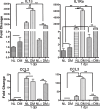Hyperglycemia-Suppressed Acod1 Expression Contributes to Innate Immune Deficiency in Pseudomonas aeruginosa Keratitis
- PMID: 40673739
- PMCID: PMC12282635
- DOI: 10.1167/iovs.66.9.51
Hyperglycemia-Suppressed Acod1 Expression Contributes to Innate Immune Deficiency in Pseudomonas aeruginosa Keratitis
Abstract
Purpose: Diabetes mellitus (DM) patients are at higher risk for infections, which are often more severe. This study investigated the role of aconitate decarboxylase 1 (Acod1) and its product, itaconate, in innate defense against bacterial keratitis and its impairment in type 1 DM mice.
Methods: Wild-type or normal (NL), streptozotocin-induced DM, and Acod1-/- mice were inoculated with Pseudomonas aeruginosa (Pa) with or without 4-octyl itaconate (4-OI), a cell-permeable derivative of itaconate. Keratitis severity was determined by photography, clinical scores, Pa burden (cfu), and myeloperoxidase (MPO) activity. Gene expression was determined by quantitative PCR. Immune and Acod1-positive cells were determined by immunohistochemistry.
Results: DM mice expressed lower levels of Acod1 in B6 mouse corneas, and Pa infection triggered its upregulation, mostly in infiltrated cells. Acod1 deficiency increased the severity of Pa keratitis and significantly augmented the expression of Il-1β, Il-1ra, and Ccl3, but not Ccl2, at 1 day post-infection (dpi). Acod1-/- increased neutrophil but decreased macrophage infiltration. 4-OI prevented Pa infection in NL corneas (P = 6.7E-05) and alleviated Pa keratitis in DM corneas (P = 0.000204) at 3 dpi. Hyperglycemia augmented Pa infection-induced Il-1β, Il-1ra, and particularly Ccl3, but not Ccl2. In DM corneas, 4-OI greatly dampened the expression of CCL3 but not CCL2, compared to DM corneas without the treatment. The presence of 4-OI significantly reduced the severity of Pa keratitis in Acod1-deficient mice.
Conclusions: Acod1/itaconate is crucial for mediating protective immune responses against Pa infection in both NL and DM corneas. Acod1 activation and/or itaconate-based therapies may offer promising adjunctive treatments for microbial keratitis in patients with diabetes.
Conflict of interest statement
Disclosure:
Figures







References
MeSH terms
Substances
Grants and funding
LinkOut - more resources
Full Text Sources
Medical
Research Materials
Miscellaneous

